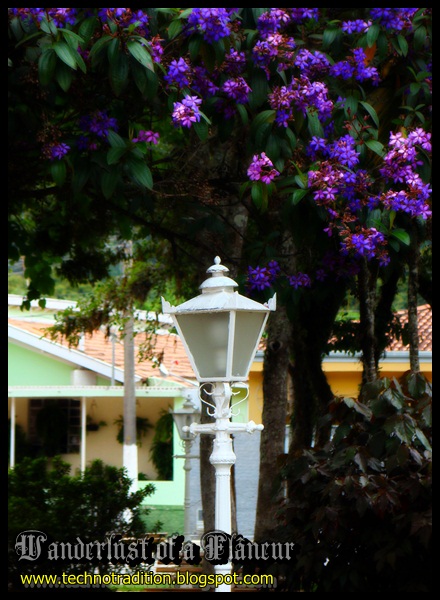The coat of arms of São Bento do Sapucaí is formed by a silver mural crown, representing a city, a Portuguese shield with the Medal of Saint Benedict, the Patron Saint of the city, two hunting horns surrounding the medal representing one of the main sources of income for the municipality, a mountain shape representing Pedra do Baú, green fields representing the nature characteristic of the city and the river representing Sapucaí River.Below there is on the centre the name of the town and on the sides "1832" representing the first parish built and "1858" representing the year of emancipation. On the two sides of the shield there are crops representing the production of rice and corn.
State: São Paulo
Country: Brazil
My Commentary: São Bento do Sapucaí is a very cozy town, not exactly urban and full of museums, it's quite more countryside and there are places to visit but it's better to prepare the route before going, marking all the places to visit by car if possible. One aspect I like is that one can walk through the central area and have a nice time, many Brazilian towns are crazy in their central areas, but not São Bento do Sapucaí.
Links:
Interesting Facts:
- São Bento do Sapucaí has the status of "Estância Climática" given by the State of São Paulo which means that the town is a place with special weather, nature, water and/or air condition.
- Pedra do Baú complex in São Bento do Sapucaí is one of the highest points of the State of São Paulo
- "Troop of Zé Pereira" is the name of a carnival group which parades with huge effigies (a tradition brought from Portugal)
- Plínio Salgado, founder of the Brazilian Integralism, a Christian Conservative movement during the 30's, was born in São Bento do Sapucaí.
History of São Bento do Sapucaí: First settlings in that area were made by Bandeirantes that went up the Serra da Mantiqueira trying to reach the gold mining regions of Minas Gerais. The town was founded on August 6, 1832 and Saint Benedict was chosen as the patron saint. The name of the place comes from the saint (São Bento in Portuguese) and the river Sapucaí, that crosses town. Around the year 1820 to 1822, José Pereira Alvares and other resident farmers who lived at Sapucai Mirim River, land of Pindamonhangaba at that time, purposed to erect a chapel dedicated to Nossa Senhora (Mary mother of Jesus), in the place where now stands the current Nossa Senhora do Rosário church. Because of the brawl with the inhabitants of the municipality of Camanducaia in territory of Minas Gerais they were forced to paralyse the chapel building works (Paulistas constantly had problems with Mineiros). Around 1850, José Pereira Alves and his wife, Ignez Leite de Toledo donated a large area of land to the town, with the purpose of building a great church in honor of St. Benedict. The town's folk went in a religious procession to retrieve an image of the saint from the nearest chapel (which was almost in Sapucaí-Mirim, Minas Gerais), and then the "Igreja Matriz de São Bento" (St. Benedict's Church) started to be built by the slaves. Still today, you can find in there paintings of well-known artists that date back to 1853.
Anthem of São Bento do Sapucaí:
Erguei ó gente da serra
Erguei contente o olhar
Um clarão que a vida encerra
Sobre nós ei-lo a brilhar
Uma estrela alviçareira
A infância aclara a conduz
Nos cimos da Mantiqueira
Resplandece nova luz
Honrando a terra Paulista
Um templo novo hoje ergueis!
Respeitoso é o Sambentista
Do progresso às grandes leis
Alçai o olhar a mocidade
Na frente haveis de seguir
Caminhai que a claridade
Mostra louros no porvir
Trip To São Bento do Sapucaí in January 2013
My Commentary: This was the first time I could really visit and explore São Bento do Sapucaí. The town is cosy, countryside styled and full of nature. With a little research it's possible to set a route and visit the historical places there. As many towns in the region, São Bento do Sapucaí had its part on the Paulista Revolution in 1932.
 |
| Map of São Bento do Sapucaí on a wall |
 |
| Carnival effigies in São Bento do Sapucaí |
 |
| Museum for the Paulista Revolution at Pousada Quilombo |
 |
| Museum for the Paulista Revolution at Pousada Quilombo |
 |
| Museum for the Paulista Revolution at Pousada Quilombo |
 |
| Museum for the Paulista Revolution at Pousada Quilombo |
 |
| Museum for the Paulista Revolution at Pousada Quilombo |
 |
| Museum for the Paulista Revolution at Pousada Quilombo |
 |
| Museum for the Paulista Revolution at Pousada Quilombo |
 |
| Museum for the Paulista Revolution at Pousada Quilombo |
 |
| Museum for the Paulista Revolution at Pousada Quilombo |
 |
| Museum for the Paulista Revolution at Pousada Quilombo |
 |
| Museum for the Paulista Revolution at Pousada Quilombo |
 |
| Museum for the Paulista Revolution at Pousada Quilombo |
 |
| Quilombo Neighbourhood in São Bento do Sapucaí |
 |
| Church at Quilombo Neighbourhood in São Bento do Sapucaí |
 |
| Quilombo Neighbourhood in São Bento do Sapucaí |
 |
| A story of Quilombro neighbourhood |
 |
| Monsigneur Pedro do Vale Moneiro: A holy man who besides being a priest, supported São Paulo loyally during the Paulista Revolution in 1932 |
 |
| Monsigneur Pedro do Vale Moneiro: A holy man who besides being a priest, supported São Paulo loyally during the Paulista Revolution in 1932 |
 |
| Monsigneur Pedro do Vale Moneiro: A holy man who besides being a priest, supported São Paulo loyally during the Paulista Revolution in 1932 |


















































































No comments:
Post a Comment